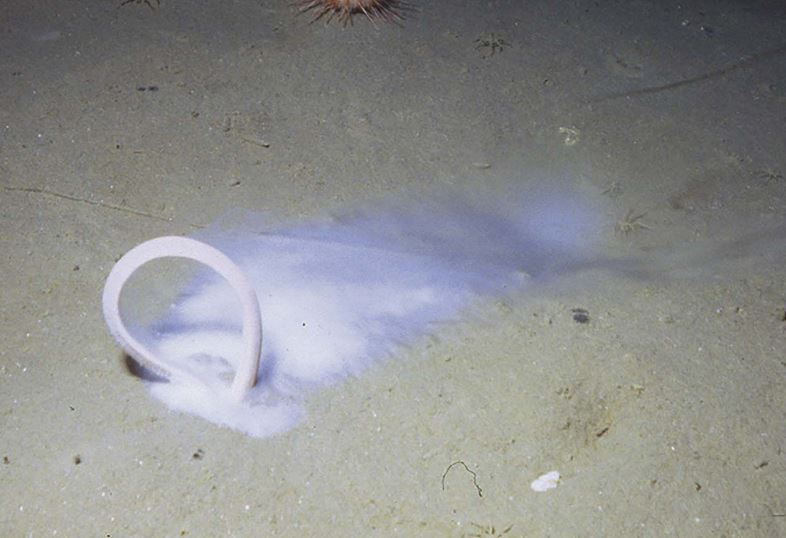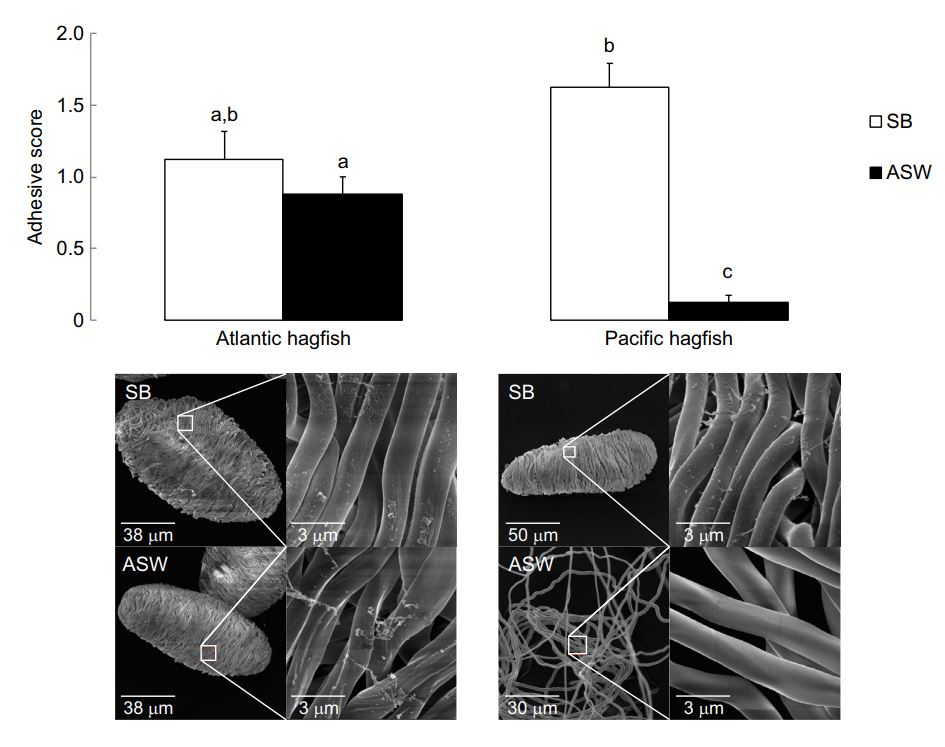Hagfish. You love them. I love them. Of all the fish in all the seas, none are more magnificent than the hagfish. Across the world, children celebrate the hagfish by making slime from Elmer’s glue, their own mucous, or just, like, something. Seriously, how is is that toddler hands are always coated in some strange, unidentifiable slime?
And never, ever forget:
Your car has just been crushed by hagfish: Frequently Asked Questions.
2018 was a big year in hagfish science. Below are just a few of my favorite studies.
Biogeography
A hagfish in the high Antarctic? Hagfish have previously never been observed in the shallow waters around Antarctic, but a photograph from 1988 was determined this year to be a hagfish feeding on a large pile of clam sperm in shallow water. Neat!

Incidentally, the reason the photo languished for so long is that it was originally though to be a Nemertean. Because Antarctic Nemertean worms are huge and horrifying.
- Dayton and Hammerstrom (2018) A hagfish at Salmon Bay, McMurdo Sound, Antarctica? DOI: 10.1017/S0954102018000202.
Physiology
How much time to make hagfish slime when a hagfish slimes on time?
Answer: More than a month.
Interestingly, it’s not the legendary mucous that’s the limiting factor, but rather those tightly wound skeins of filament that lend the mucous its incredible strength.
- Schorno and friends (2018) Cellular mechanisms of slime gland refilling in Pacific hagfish (Eptatretus stoutii). DOI: 10.1242/jeb.183806.
If you were wondering whether hagfish would be negatively impacted by ocean acidification, worry not! Hagfish have a profound capacity to deal with increased carbon dioxide in the ocean. This is likely an adaptation to their preference for chilling out inside the dead, bloated carcasses of marine animals.
Bonus points for what appears to be a dubstep pun.
- Clifford and friends (2018) Dropping the base: recovery from extreme hypercarbia in the CO2 tolerant Pacific hagfish (Eptatretus stoutii). DOI: 10.1007/s00360-017-1141-2.
This is one of the best abstracts I’ve ever read, so rather than summarizing the study, let’s let the authors do it:
The defensive slime of hagfish consists of a polyanionic mucin hydrogel that synergistically interacts with a fiber network forming a coherent and elastic hydrogel in high ionic strength seawater. In seawater, the slime deploys in less than a second entrapping large quantities of water by a well-timed thread skein unravelling and mucous gel swelling. This rapid and vast hydrogel formation is intriguing, as high ionic strength conditions generally counteract the swelling speed and ratio of polyelectrolyte hydrogels. In this work we investigate the effect of ionic strength and seawater cations on slime formation dynamics and functionality. In the absence of ionic strength skeins swell radially and unravel uncontrolled, probably causing tangling and creating a confined thread network that entraps limited water. At high ionic strength skeins unravel, but create a collapsed and dense fiber network. High ionic strength conditions therefore seem crucial for controlled skein unraveling, however not sufficient for water retention. Only the presence of naturally occurring Ca2+ or Mg2+-ions allowed for an expanded network and full water retention probably due to Ca2+-mediated vesicle rupture and cross-linking of the mucin. Our study demonstrates that hagfish slime deployment is a well-timed, ionic-strength, and divalent-cation dependent dynamic hydrogel formation process.
Böni and friends 2018
- Böni and friends (2018) Effect of ionic strength and seawater cations on hagfish slime formation. DOI: 10.1038/s41598-018-27975-0.
Temperature change is a different story, with clear trade-offs measured when lukewarm hagfish are exposed to cold and warm water.
- Giacomin and friends (2018) Acute temperature effects on metabolic rate, ventilation, diffusive water exchange, osmoregulation, and acid–base status in the Pacific hagfish (Eptatretus stoutii). DOI: 10.1007/s00360-018-1191-0.
Hagfish slime is really weird. When exposed to seawater, it can expand to 10,000 times its volume and just get all over pretty much everything. Remarkably, the underlying material structure of the slime remains shockingly consistent regardless of the concentration of the fluid it’s in. It’s just as elastic, just as cohesive, and just as frustrating to clean out of your work clothes.
Which is a pretty unusual property.
- Chaudhary and friends (2018) Concentration-independent mechanics and structure of hagfish slime. DOI: 10.1016/j.actbio.2018.08.022.
Sometimes hagfish cough. Sometimes they snortle themselves awake. This amuses me.
- Eom and Wood (2018 ) The ventilation mechanism of the Pacific hagfish Eptatretus stoutii. DOI: 10.1111/jfb.13885.
Evolution
Hagfish store there slime in tightly wrapped coils, waited to expand to fill whatever container, shark’s mouth, or Toyota Prius threatens them. But all hagfish slime is not created equal. Atlantic hagfish are high-strung and require vigorous mixing in order to release the full fury of their secretions. The much more laid bag Pacific hagfish simply need to expose their slime to seawater for it to waft gently outwards to choke the gills of a surprised shark.

The evolutionary origins of the underlying variation in these protein structures which allows for differences in hagfish slime secretion appear to be wholly novel, unique to hagfish and hagfish alone with no known analogues.
- Bernards and friends (2018) Unraveling inter-species differences in hagfish slime skein deployment. DOI: 10.1242/jeb.176925
Hox genes are weird and complicated and control embryo development in most animals. They’re also super well-conserved into deep evolutionary time (you don’t mess with the Hox if you want your offspring to function). But Hox genes are expressed differently in invertebrates and vertebrates. Almost nothing, however, is known about how Hox genes are expressed in jawless fish like hagfish. Is it more like invertebrates or like jawed fishes? How deep into our evolutionary passed does Hox gene expression go.
Spoilers: Hagfish express Hox genes more like jawed fishes (of which we’re pretty much a subset). Zoinks!
- Pascual-Anaya and friends (2018) Hagfish and lamprey Hox genes reveal conservation of temporal colinearity in vertebrates. DOI: 10.1038/s41559-018-0526-2.
Technology
This one is pretty far from my expertise but here’s the gist:
When properly treat, hagfish intermediate filaments (one of the main components of slime) can create a nano-material that produces a tough, stiff fabric when dry that expands, softens, and becomes incredibly elastic when wet. By a factor of about 1000. Which seems pretty cool and probably useful.
- Böni and friends (2018) Structure and Nanomechanics of Dry and Hydrated Intermediate Filament Films and Fibers Produced from Hagfish Slime Fibers. DOI: 10.1021/acsami.8b17166.
People all over the world cook and eat hagfish and we use their skin for things like eel skin wallets and belts. What I didn’t know is that you can also use hagfish skin to make food-grade gelatin for packaging. And you can make that packaging cinnamon flavored, if you wish.
- Kim and friends (2018) Development of a hagfish skin gelatin film containing cinnamon bark essential oil. DOI: 10.1016/j.lwt.2018.06.016.
